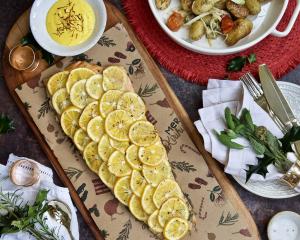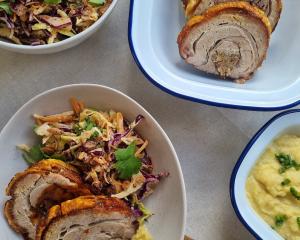
"I know real life tends to be messier and more spontaneous ... and I want the recipes in this book to reflect the reality of our lives today."
As a business owner and chef he often finds himself running from meeting to meeting, to phone call to phone call to home and back again.
It means he is often not home to eat with his son so when he is home in the week or weekends he makes it a priority to do some cooking with him.
Not eating as a family every night is common for lots of working parents.
"We need to be honest about this and recognise there is nothing wrong with it. All it means is it is up to us to make the time we are around count."
So on a Sunday he often does a big roast or slow-cooked stew and it is the time when friends and family get together.
"There is nothing better than filling the house with delicious smells of whatever it is you’re cooking."
But he is quick to urge people not to put any pressure on themselves to have a picture-perfect lifestyle and he is not concerned if there is a bottle of tomato or brown sauce on the table either.
"I’ll let you in on a little secret ... I often can’t resist a good dollop of brown sauce too."

"Through quick ways to add maximum flavour and clever hacks in the kitchen, I want to share with you how to make the most of your supermarket staples."
He has organised his latest book Real Life Recipes to reflect how most people eat — lunch, tea, something a bit fancier and treats with some recipes "signposted" as being quick to cook in about 30 minutes, ones suitable for freezing or keeping in the fridge later and slow-cooked dishes.
"I’d like this book to enable us all to eat tasty, satisfying meals in a way that reflects how we are cooking today."
He also gives a guide to cheats and time-savers using pre-prepared ingredients such as curry pastes, frozen fruit and vegetables and tinned beans.
In another section he suggests some flavour boosts that are big on impact and can help people achieve delicious meals without having to spend more time in the kitchen.
These include cheese, chillies, condiments such as caramelised onion chutney, rose harissa or tapenade, tinned fish, spices and herbs.
"Some of these might sound a bit luxurious, but you only need small amounts to create intense nuggets of flavour."
The book
Tom Kerridge Real Life Recipes, Bloomsbury

Harissa-roast pumpkin and feta salad
Roasting pumpkin or butternut squash brings out all its natural sugars, which is perfect next to the spicy kick from rose harissa and contrasting cooling feta cheese. The roasted chickpeas and toasted pumpkin seeds provide a delicious, moreish crunch.
Serves 2
Ingredients
500g deseeded pumpkin (or butternut squash), cut into wedges
400g tin chickpeas, rinsed and drained
4 Tbsp extra virgin olive oil
1 Tbsp rose harissa
1 tsp wholegrain mustard
Juice of ½ lemon
1 Tbsp white balsamic vinegar
100g baby spinach leaves
100g feta
Salt and freshly ground black pepper
2 Tbsp pumpkin seeds, toasted, to finish
Method
Preheat the oven to 200degC/fan 180degC.
Place the pumpkin (or squash) and chickpeas on a baking tray. Drizzle with one tablespoon of the extra virgin olive oil and the harissa and sprinkle with salt and pepper.
Mix well with your hands so both the pumpkin and chickpeas are coated well. Roast on a high shelf in the oven for 20-25 minutes, or until just tender.
Meanwhile, for the dressing, in a medium bowl, mix together the mustard, lemon juice, balsamic vinegar and remaining three tablespoons of olive oil.
Season with salt and pepper to taste. Transfer two tablespoons of the dressing to a small bowl and set aside.
Take the tray of pumpkin (or squash) and chickpeas from the oven and set aside to cool slightly.
Add the spinach leaves to the dressing in the medium bowl and toss gently to coat. Divide the spinach between two plates.
Distribute the roasted pumpkin (or squash) wedges and chickpeas over the spinach and crumble over the feta.
Sprinkle with the toasted pumpkin seeds and trickle over the reserved dressing to serve.

Blueberry baked cheesecake
I prefer baked cheesecakes to those set with gelatine, as they have a bit more character. You’re not looking for perfection here, so don’t worry if your cheesecake cracks on the surface in the oven — it’s all part of its charm.
Serves 9-12
Base
250g digestive biscuits
120g butter, melted
Filling
900g cream cheese
200g caster sugar
4 large free-range eggs, plus
1 extra egg yolk
2 tsp vanilla bean paste
Finely grated zest and
juice of 1 lemon
200g creme fraiche
Blueberry sauce
100ml water
100ml caster sugar
300g blueberries
3 tsp cornflour,
mixed with 1 Tbsp water
Method
Preheat the oven to 180degC/fan 160degC.
Line the base of a 23cm-round springform cake tin: flip the base of the cake tin over and lay a piece of baking paper over it, then tuck this into the open springform ring and close it over the base (so the base is flat side up); trim off excess paper.
Crush the digestive biscuits in a food processor (or you can pop them in a strong plastic bag and bash them gently with a rolling pin).
Mix the crushed biscuits with the melted butter, tip them on to the lined base of your tin and flatten down evenly with the back of a spoon.
Place in the oven for 10 minutes to bake lightly, then remove and set aside to cool slightly, while you make the filling.
In a large bowl, beat the cream cheese to soften, using an electric whisk.
Gradually beat in the sugar, whole eggs and extra egg yolk.
Lastly, add the vanilla, lemon zest and juice, and the creme fraiche and beat until smoothly incorporated.
Pour the filling over the cheesecake base in the tin. Stand the cake tin on a baking tray and bake on a low shelf in the oven for about 45-50 minutes.
Once cooked, the cheesecake should still have a slight wobble in the middle. Turn the oven off and leave the cheesecake inside to cool slowly, with the door slightly ajar.
Meanwhile, for the blueberry sauce, put the water and sugar into a small saucepan over a medium heat to dissolve the sugar. Bring to the boil and let boil for 2 minutes, then add the blueberries.
Cook for 2-3 minutes, until the berries have released some colour into the syrup but are still plump.
Stir in the cornflour mix and cook, stirring, until the mixture thickens. Pour the blueberry sauce into a shallow dish and leave to cool. Refrigerate until you need it.
When ready to serve, run a palette knife around the inside of the cake tin to loosen the sides of the cheesecake, then carefully release it from the tin.
Transfer the cheesecake to a serving plate and spoon the blueberry sauce over the top. Cut into wedges to serve.

Pork pot roast with cider and apples
This one-pot pork roast made with cider and apples is a real celebration of the West Country. Mustard adds a subtle warmth and honey lends a little sweetness. It’s a stress-free way of cooking that’s like a casserole, but with the meat in one piece.
Serves 4-6
Ingredients
1.8kg rolled pork shoulder joint, skin scored
2 Tbsp olive oil
3 onions, finely sliced
4 garlic cloves, finely sliced
3 Tbsp plain flour
400ml cider
400ml chicken stock
Small bunch of thyme (tied with string)
12 sage leaves
2 bay leaves
4 Granny Smiths (or other crisp, tart eating apples)
1 Tbsp wholegrain mustard
1 tsp honey
Salt and freshly ground black pepper
Method
Preheat the oven to 190degC/Fan 170degC.
Season the pork on all sides with salt and pepper, rubbing a little extra salt into the scored lines of the skin.
Heat the olive oil in a large non-stick casserole pan over a medium heat.
Add the pork to the pan, skin side down, and colour well on all sides – the skin should be nicely crispy and browned.
Lift the pork out on to a plate and set aside.
Add the onions to the pan and saute for 2 minutes, then toss in the garlic and cook for another 2 minutes.
Stir in the flour and cook, stirring, for another couple of minutes.
Add half of the cider and chicken stock along with the herbs and stir well.
Bring the liquor to a gentle simmer and then return the pork to the pan.
Put the lid on and place on the middle shelf of the oven to cook for 2 hours.
Just before the 2 hours’ cooking is up, peel, quarter and core the apples.
Take the pan from the oven and remove the lid.
Add the apples and mustard then stir in the remaining cider and stock.
Return the uncovered pan to the oven and cook for another 30 minutes.
Remove the pan from the oven and transfer the pork to a warmed serving platter. Leave to rest for 10 minutes before carving.
Stir the honey through the sauce then taste for seasoning and adjust as necessary.
Carve the meat into slices and break the crackling into pieces.
Serve with some apple and cider sauce and sauteed tender-stem broccoli or other green veges.












